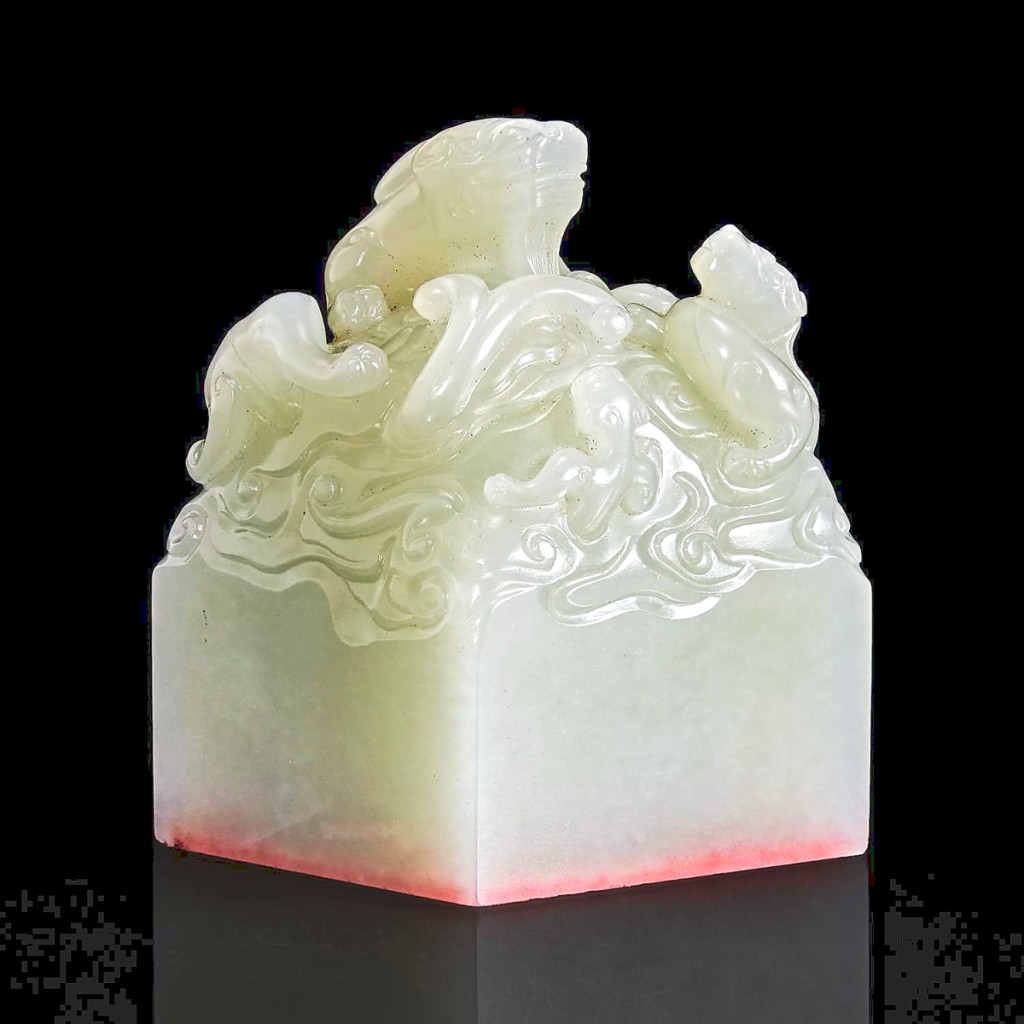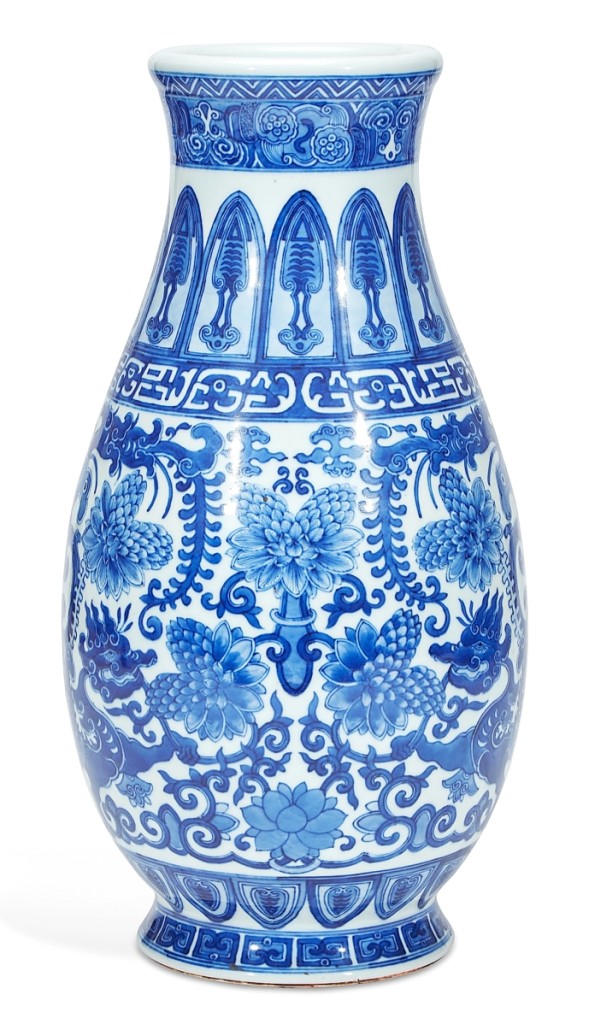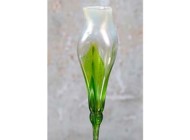
It was expected to be the sale’s top lot and it was. The rare imperial “Emperor Emeritus” celadon-white jade seal, an outstanding example of Chinese jade carving, sold for $378,000.
Review by W.A. Demers, Photos Courtesy Freeman’s
PHILADELPHIA – As expected, at Freeman’s Asian art auction on October 14, a rare imperial “Emperor Emeritus” celadon-white jade seal of great cultural and historical importance sat at the top of the 256 lots offered, selling at $378,000. The sale total was $1,593,396, with a sell-through rate of 84.92 percent. Registered bidders numbered 371.
The sale revealed the continuing resilience of the market for Asian arts, witnessed earlier in the year at the firm when an imperial Chinese vase sold for $2.3 million. Once again, competitive bidding among international buyers pushed sale prices far higher than their estimates. Ben Farina, head of Asian Arts at Freeman’s, expressed delight with the strong sale, commenting, “We had a number of wonderful pieces from various regional collections, and we’ve greatly enjoyed working with the consignors to bring this material to auction.” Farina added that because a lot of the items were coming out of private collections, it allowed the firm to be conservative with estimates. “This field, particularly with Chinese works of art, is fraught with all sorts of issues, in terms of authenticity and the like. I think that people really appreciate the fact that pieces are coming out of old, private collections that are well documented, and that gives them the additional confidence to bid on them.”
An outstanding example of Chinese jade carving, the seal’s upper face is gracefully sculpted with a qilong and two smaller qilong among scrolling waves or clouds, likely referring to the Chinese saying “Canlong jiaozi,” which may be translated as “the Eastern [blue] dragon teaching his son(s).” The “Taishang Huangdi Zhi Bao” seal arrived at Freeman’s from a private collection and was presented with an estimate of $300/500,000. Freeman’s could not identify the buyer, save to say it was a private collector.
The seal’s historical importance derives from the Qianlong emperor of China – “Emperor Emeritus” – who made a vow to voluntarily abdicate the throne to his heir in 1795 if he was blessed with a reign of 60 years. Remarkably, he reached this significant milestone, fulfilled his vow and designated his 15th son, Prince Jia, as his successor. Post-retirement, “Emperor Emeritus” commissioned approximately 20 “Taishang Huangdi” seals, which were executed in a variety of sizes, forms and materials. The jade seal sold at Freeman’s is from this select group, consigned by descendants of the original collector. Its carving and polish are exceedingly fine, as would be expected of a work commissioned by the Qianlong emperor, a connoisseur of jades.

Spirited bidding took this Chinese handscroll of eight works depicting One Hundred Auspicious Subjects from the Chinese School, Nineteenth Century or earlier, to $113,400 against an estimate of $8/12,000.
The emperor’s seal was the undisputed star of the sale; however, spirited bidding wars resulted in several lots soaring well above their estimates. A Chinese handscroll of eight works depicting One Hundred Auspicious Subjects from the Chinese School, Nineteenth Century or earlier, sold for $113,400 against an estimate of $8/12,000). “That was a wonderful price,” said Farina, “And we suspect that beyond the fact that it’s coming from a nice old collection is the fact that a number of seals and inscriptions were suggestive of an origin coming from one of the Daoguang’s member’s library.” Also, a Chinese faux bronze porcelain shell-form coupe achieved $50,400, 33 times its high estimate of $1,500, and a Chinese flambé-glazed hu-form vase left its $2,000 high estimate far behind, achieving $21,420.
A run of Chinese blue and white vases consistently met or outperformed estimates. A rare and unusual large Chinese blue and white porcelain Ming-style meiping vase drew multiple competing bids, eventually realizing $50,400. Finely potted, the vase had a tapering body with swelling shoulder and slight waisted neck, and was boldly painted with three fruiting and floral sprays with peach, pomegranate and lychees as well as chrysanthemum, prunus and peony floral sprays.
Fetching $32,750 ($10/15,000) was an unusual large Chinese blue and white porcelain archaistic vase, Qianlong six-character seal mark, its body decorated with two pairs of strong kuilong gripping stylized peony scrolls, all among elaborated scrollwork and lotus blossoms. At 17¾ inches tall and from a private Bucks County, Penn., collection the vase’s stylized dragons, peony scrolls and elaborate scrollwork all appear to relate to the decoration found on a pair of bowls with six-character Chenghua mark, according to catalog notes, but dated to the Kangxi period, from the collection of F. Gordon Morrill, sold at Doyle’s New York in September 2003.
Also from the Bucks County collection was a large (17 inches) Chinese blue and white porcelain baluster vase with decoration depicting three vivid mythical beasts in a dramatic landscape with crashing waves, cloud scrolls to the neck. It achieved $27,720, more than doubling its high estimate.

Fetching $32,750 ($10/15,000) was an unusual large Chinese blue and white porcelain archaistic vase.
Rounding up the notable Chinese blue and white vases at $25,200 was a tall rouleau example with slightly rounded sides rising to an angled shoulder, columnar neck and galleried rim. The body was painted in bright cobalt tones with a narrative scene set outdoors with sages at various pursuits, including playing weiqi among rocks, rivers and trees. The Bucks County collection also contributed a pair of Chinese blue and white porcelain bowls, 6½-inch diameter, Daoguang mark and probably of the period, which rose to $23,940. Both featured deep, rounded sides rising to a slightly flaring rim, decorated on the exterior with a frieze of peony scroll above a lappet band, and on the center of the interior with a peony spray roundel.
Though the majority of the highlights of Asian arts were Chinese in origin, several Buddhist sculptures from throughout Southeast Asia elicited significant buyer interest. A Nepalese gilt-copper alloy figure of Vasudhara achieved $47,250 ($12/15,000), while a Sino-Tibetan gilt-bronze figure of Akshobhya likewise sparked a bidding war, selling for $30,240, more than four times its high estimate ($5/7,000).
Furniture in the sale was led by a Chinese lacquered hardwood southern official’s hat armchair, possibly huanghuali, Eighteenth/Nineteenth Century, which found a buyer at $21,420. The chair’s humpback-shaped crestrail was supported on a curved back splat carved and pierced with two ruyi medallions, flanked by a pair of curved stiles. It featured out-curved arms supported by tapering stiles and curved front posts and it had rectangular caned seat above a simple arched apron, the legs joined by a box stretcher, with front footrest.
The lot was accompanied by a copy of R. Soame Jenyns and William Watson’s Chinese Art, The Minor Arts, Fribourg, 1963, in which the chair was illustrated. Catalog notes stated that the chair was formerly in the collection of Harry J. Haon II (1901-1989) and descended in his family. Haon was employed by E.I. du Pont de Nemours & Company, and was promoted in 1954 to the foreign relations department as manager of the European Office, London, England, until his retirement in 1962, after which he continued to live part-time in London into the late 1970s. It is believed that many of the Asian arts in his collection were acquired during this time in London.
Additional highlights in the sale included a Chinese flambé-glazed hu-form vase, Guangxu mark and possibly of the period, with a pear-shaped body, bringing $22,270; a Qing dynasty Chinese carved bamboo brush pot, well-carved with three drunken sages riding a horse, buffalo and deer with the assistance of attendants in a landscape with rocky mountains, pine and other trees, going out at $20,160; a large Qing dynasty pale celadon and russet jade archer’s ring with imperial poem and hunting scene that was bid to $19,530; an unusual and large Japanese embellished and gold-decorated rootwood hibachi, earning $17,649; and an ink and color on paper by Zhang Shuqi (Chinese, 1901-1957), “Bird on Bamboo with Morning Glories,” 1948, that left the gallery at $16,389.
Prices given include the buyer’s premium as stated by the auction house. The firm’s next Asian art auction will be conducted in April. For information, www.freemansauction.com or 215-563-9275.




















